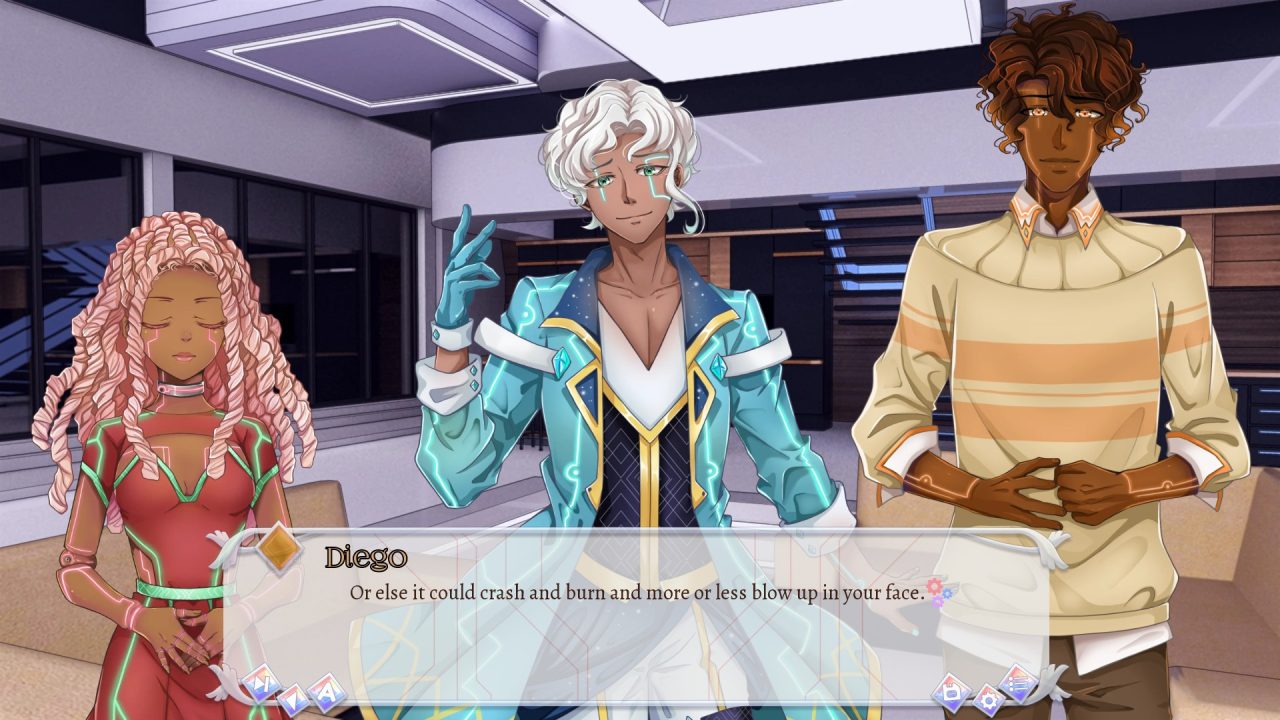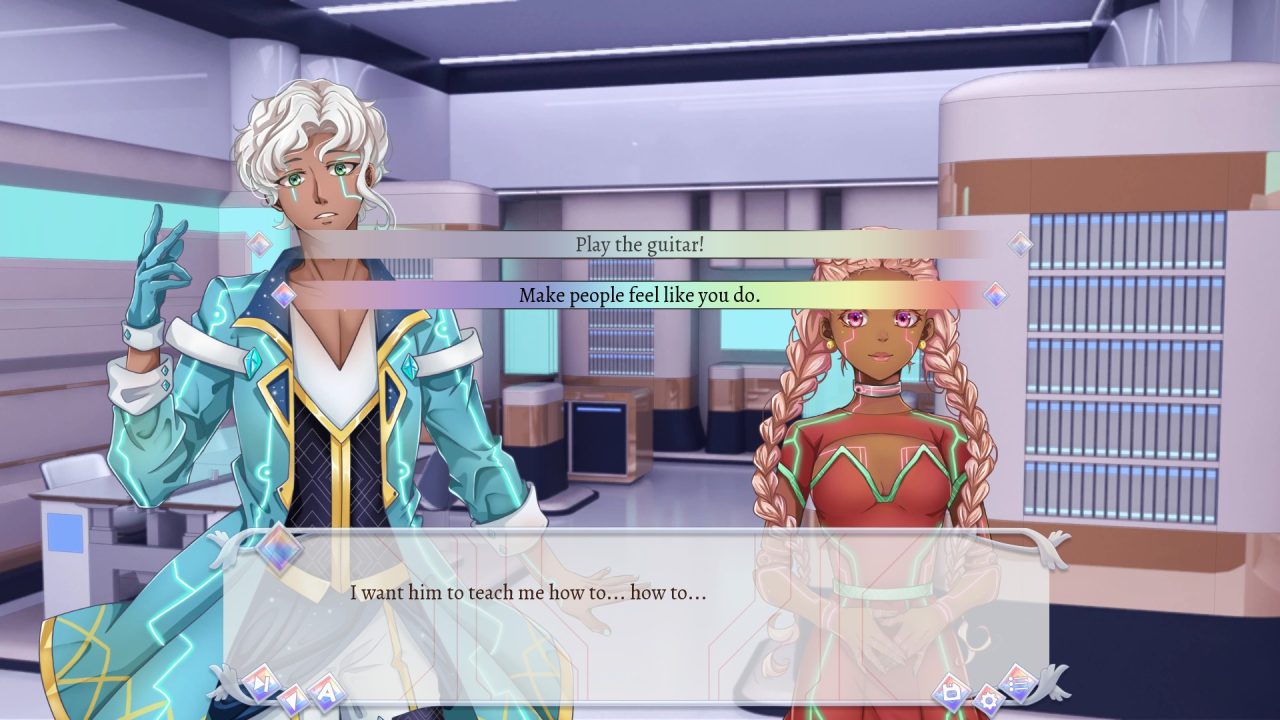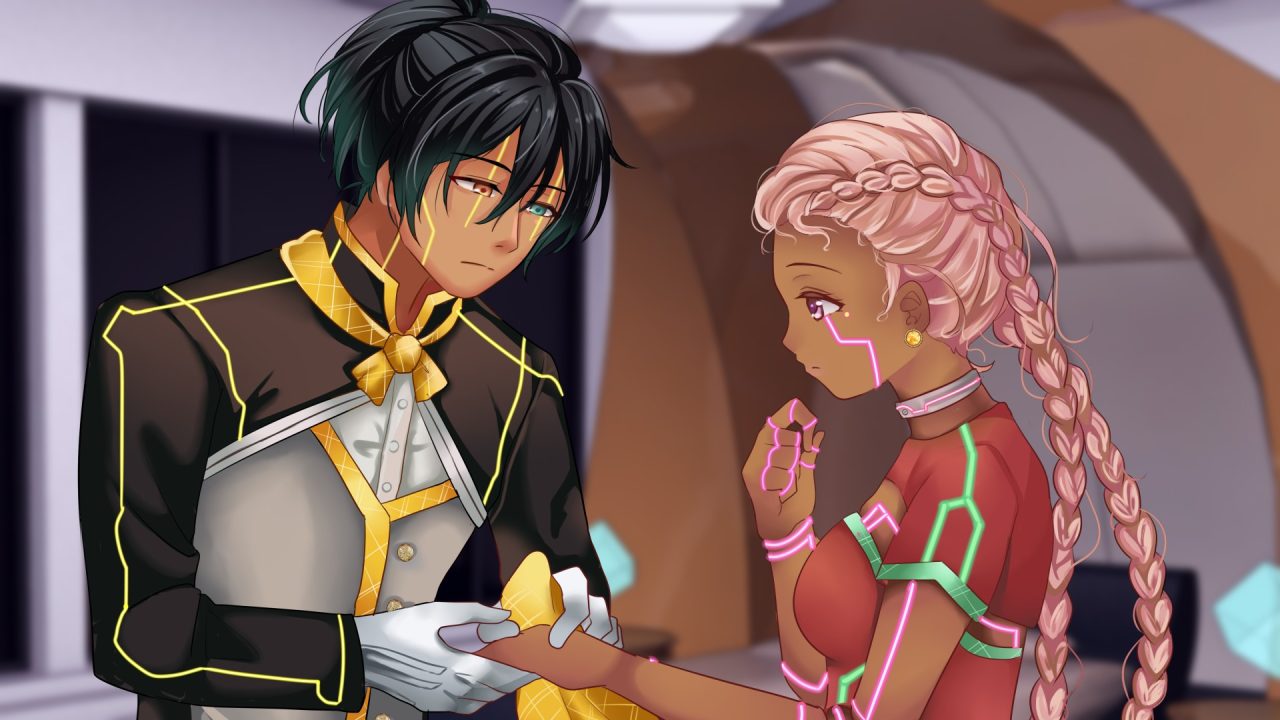What does becoming sentient in a world that isn’t ready for you mean? Dreamweaver android model Aureve must find out in Belle Automata: Chronicle I, an indie otome visual novel by Jellyfish Parade. Aureve’s journey of self-discovery intertwines with a cast of likable characters in a sci-fi narrative as she figures out her life’s path and what’s hidden within her heartcore.
Belle Automata’s story begins in a curious-yet-emotional fashion, with Aureve reflecting on her recently deceased former master and father figure, Lenthes. Not too long after his death, Lenthes’ family decides his android is of no consequence, selling her to a mysterious buyer known only through the online handle Nightmare Prince. Aureve is still processing this turn of events on the doorstep of her new home, though her situation is even more bizarre than she initially thought. Aureve soon discovers that the Nightmare Prince’s residence is a sanctuary for rogues, androids with a developed sense of self outside their initial programming, such as herself. But why do the Nightmare Prince and his older brother Roman shelter these rogues despite humanity’s often disparaging views on androids? And will trying to live her own life mean that Aureve is somehow betraying Lenthes or what she was initially programmed to do? The narrative explores these questions along with compelling romances.
Belle Automata’s storyline is as much about discovering yourself as it is about finding romance, with Aureve finding a path throughout Chronicle I’s narrative in conjunction with love. Yes, the romance is heavily there, but it’s very realistic. There are several “growing pain” moments within the narrative in which Aureve and other characters must process their feelings or deal with differing opinions. However, I appreciate that the characters still find ways to show how they care while not entirely compromising their viewpoints. Chronicle I’s two “perfect endings” consist of the love interests Victor and the Nightmare Prince finding ways to stay together with Aureve despite the many hurdles thrown their way, showcasing just how unique and rewarding that kind of affection can be.

Under its sci-fi veneer, the game’s messages are relatable, and the plot shines with excellent character moments and a gentle storytelling approach. Some of my favorite Chronicle I characters were the side characters such as the musically-charged Zaffre, kindly innocent Diego, absent-minded Klaus, and mysterious Roman. They were all noteable and their roles in this game have me eager to see how the future Chronicles will play out! Aureve is also an absolute delight of a heroine. I loved seeing her grow and come into her own in each route. The Nightmare Prince and Victor round out the cast and also leave their mark. In addition, their featured love stories were exceptionally well-written.
Belle Automata is a traditional visual novel (VN). You-as-Aureve progress through the story, reading lines of dialogue and text until a decision point comes along to add interactivity. Essentially, a visual novel distills the game into a branching narrative with player interaction, most often in the form of those response points sprinkled throughout the game.
As it stands, VNs either thrive or fail depending on the strength of the story and characters. Fortunately for Belle Automata, the plot and cast are its biggest strength. At the story’s beginning, your decisions help set you on either the Nightmare Prince’s route or the strict android butler Victor’s. From there, your decisions help determine the game’s outcome and what CGs (special story scene artwork) you may uncover based on your chosen story direction. It’s pretty straightforward, and the game is readily playable via mouse and keyboard or controller. You can save at any time during play or skip through previously read text at a brisk clip. Perhaps the most exciting and beneficial gameplay feature is the unique “Rewind” that allows you to go back through previously read text without consulting a history log. The game does nothing wrong regarding its gameplay presentation and is easy enough to pick up if you’re familiar with visual novels.

From a UI stance, Belle Automata is aesthetically pleasing. The font is easy to read, and little touches, like the gears at the end of a sentence, are excellent visual cues to remind you that this story is about androids. I love Belle Automata’s warm and bright palette, which instantly brings to mind the aesthetics of other “lighter” otome titles such as Cafe Enchante or Lover Pretend. The game’s art direction is gorgeous! I love the backgrounds and how detailed the character designs are. The “Tron” line markings on the android characters’ skins are a nice touch to differentiate them from the human characters, and there’s a symmetry to the clothes that fits a futuristic setting. I also like how Aureve’s hairstyle changes in both routes too! Many facial expressions play out throughout the story scenes, and the CG illustrations are sweet. Belle Automata is a gorgeous VN.
Adding to the game’s atmosphere is its incredible sound use. Sound effects are varied and quite nicely implemented. The wooshing of a door opening or closing, the sound of a sewing machine, a chime to inform someone that an intercom is in use: every effect adds to the player’s immersion. The android characters’ voices and the Nightmare Prince’s early masked audio have a synthetic filtered quality, adding another layer to the storytelling. The music tracks fit a sci-fi story and excellently interweave throughout the game. I must also mention Belle Automata’s phenomenal voice acting! Aureve and the other characters come alive through magnificently emotive performances.

Truthfully, I’m hard-pressed to find much fault with Belle Automata. It’s that solid of an otome visual novel. However, the lack of a story map or any indication of an affection-raising indicator for decisions is a misstep, as there’s no way to keep track of your previous choices. For example, suppose you’re going for the harder-to-reach perfect endings. In that case, prepare to play through both routes multiple times using the skip feature until you finally stumble upon the right combination of decisions to access the new ending scenes. It’s somewhat frustrating, but it doesn’t take much time since there are only two routes in Chronicle I.
Still, those issues are minor. I immensely enjoyed my time playing Belle Automata. A lot of work and heart is in Chronicle I, and it shows in every moment. Despite having only two routes, both are extensive, meaty affairs that go in different yet still fitting directions. Belle Automata is the type of otome VN one can lose oneself in, and I mean that in the best possible way. I’m already looking forward to the future release of the next Chronicles. All iterations of Aureve’s journey will be worth playing if this first foray is any indication!



